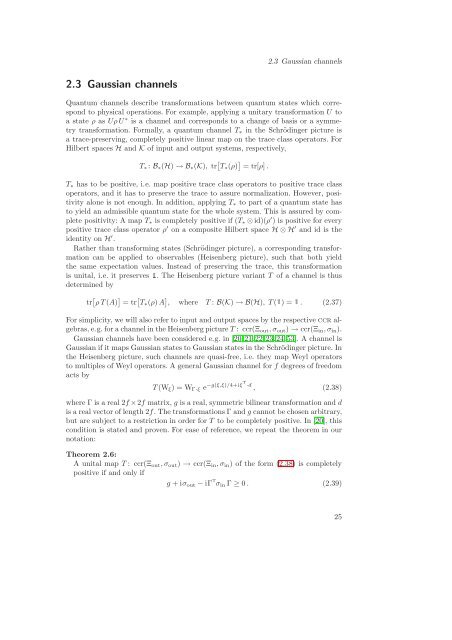Quantum Information Theory with Gaussian Systems
Quantum Information Theory with Gaussian Systems
Quantum Information Theory with Gaussian Systems
You also want an ePaper? Increase the reach of your titles
YUMPU automatically turns print PDFs into web optimized ePapers that Google loves.
2.3 <strong>Gaussian</strong> channels<br />
2.3 <strong>Gaussian</strong> channels<br />
<strong>Quantum</strong> channels describe transformations between quantum states which correspond<br />
to physical operations. For example, applying a unitary transformation U to<br />
a state ρ as Uρ U ∗ is a channel and corresponds to a change of basis or a symmetry<br />
transformation. Formally, a quantum channel T∗ in the Schrödinger picture is<br />
a trace-preserving, completely positive linear map on the trace class operators. For<br />
Hilbert spaces H and K of input and output systems, respectively,<br />
T∗: B∗(H) → B∗(K), tr T∗(ρ) = tr[ρ] .<br />
T∗ has to be positive, i.e. map positive trace class operators to positive trace class<br />
operators, and it has to preserve the trace to assure normalization. However, positivity<br />
alone is not enough. In addition, applying T∗ to part of a quantum state has<br />
to yield an admissible quantum state for the whole system. This is assured by complete<br />
positivity: A map T∗ is completely positive if (T∗ ⊗ id)(ρ ′ ) is positive for every<br />
positive trace class operator ρ ′ on a composite Hilbert space H ⊗ H ′ and id is the<br />
identity on H ′ .<br />
Rather than transforming states (Schrödinger picture), a corresponding transformation<br />
can be applied to observables (Heisenberg picture), such that both yield<br />
the same expectation values. Instead of preserving the trace, this transformation<br />
is unital, i.e. it preserves . The Heisenberg picture variant T of a channel is thus<br />
determined by<br />
tr ρ T(A) = tr T∗(ρ)A , where T : B(K) → B(H), T( ) = . (2.37)<br />
For simplicity, we will also refer to input and output spaces by the respective ccr algebras,<br />
e.g. for a channel in the Heisenberg picture T : ccr(Ξout, σout) → ccr(Ξin, σin).<br />
<strong>Gaussian</strong> channels have been considered e.g. in [20,21,22,23,24,53]. A channel is<br />
<strong>Gaussian</strong> if it maps <strong>Gaussian</strong> states to <strong>Gaussian</strong> states in the Schrödinger picture. In<br />
the Heisenberg picture, such channels are quasi-free, i.e. they map Weyl operators<br />
to multiples of Weyl operators. A general <strong>Gaussian</strong> channel for f degrees of freedom<br />
acts by<br />
T(Wξ) = WΓ·ξ e −g(ξ,ξ)/4+iξT ·d , (2.38)<br />
where Γ is a real 2f ×2f matrix, g is a real, symmetric bilinear transformation and d<br />
is a real vector of length 2f. The transformations Γ and g cannot be chosen arbitrary,<br />
but are subject to a restriction in order for T to be completely positive. In [20], this<br />
condition is stated and proven. For ease of reference, we repeat the theorem in our<br />
notation:<br />
Theorem 2.6:<br />
A unital map T : ccr(Ξout, σout) → ccr(Ξin, σin) of the form (2.38) is completely<br />
positive if and only if<br />
g + iσout − iΓ T<br />
σin Γ ≥ 0 . (2.39)<br />
25
















